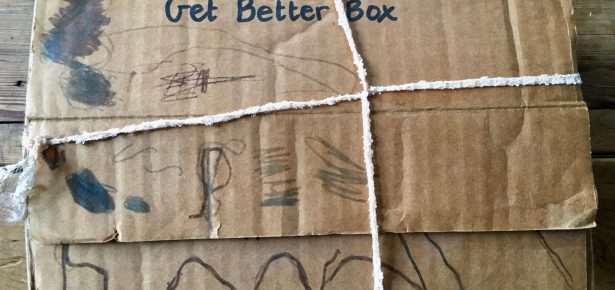
When my siblings and I were very young, our mother created a ‘Get Better Box’. This small cardboard box housed a collection of tiny toys and unusual household objects, and was brought out whenever one of us was ill, as distraction for the sick child. Tucked inside little tins, boxes, and purses were all kinds of entertaining treasures, including a mysterious animal bone, a red acrylic brooch set with miniature sea shells, a plastic film canister filled with shiny buttons, and a wooden baby doll in a matchbox. There were also pin badges, a pair of sugar tongs, a walnut pastry wheel, a cardboard alphabet that folded up into a cube, a pack of playing cards illustrated with birds, some finger puppets, various tiny puzzles, and numerous other diverting trinkets. Invalids were invited to write the details of their illness in a notebook, and sometimes we loaned the ‘Get Better Box’ to friends, whose names are recorded there too.
The ‘Get Better Box’ has miraculously survived many children and several decades, and in recently reacquainting myself with it, I am reminded of the satisfaction of opening all the little boxes and discovering their contents. Particularly striking is the multisensory appeal of these objects, especially for a sick child – the heavy clink of old coins, the soothing softness of the richly-coloured silk purses, the cool touch of the silver sugar tongs. This humble cardboard box is not only the material relic of a 1990s childhood, but a family archive, and a tactile repository of memories.
Some of these ideas about what boxes do, how we interact with them, and how they relate to material culture more widely are pertinent to my new book, Boxes and Books in Early Modern England. This project explores the imaginative significance of the box as object and idea in early modern literature. Cabinets of curiosities (perhaps the most obvious early modern predecessors to my childhood treasury) were elite objects, but a whole range of other boxes would have been found right across the social scale in early modern England. In this book I bring together close readings of boxes, chests, coffins, and books themselves as material and intellectual containers of text, thinking about how these artefacts furnished minds as much as rooms. These readings reveal distinctive patterns of thought that lead us across literary genres in sometimes unexpected but fruitful ways, to consider the shared material and imaginative influences between a translated psalm and a medical textbook, for example, or between a drama written for performance in the public playhouses and a sermon delivered in court, or between a personal diary and a piece of religious polemic.
These literary responses to the box as a particular form of materiality also offer ways in which the discipline of book history might reframe its analysis of the material text. In situating early modern books as objects within a detailed picture of other material things, especially boxes, Boxes and Books in Early Modern England invites a reconsideration of the codex as a tactile object that invites openings and closings both physical and mental, and an artefact whose material and intellectual surfaces are constantly reflecting, informing, and responding to one another.
Latest Comments
Have your say!